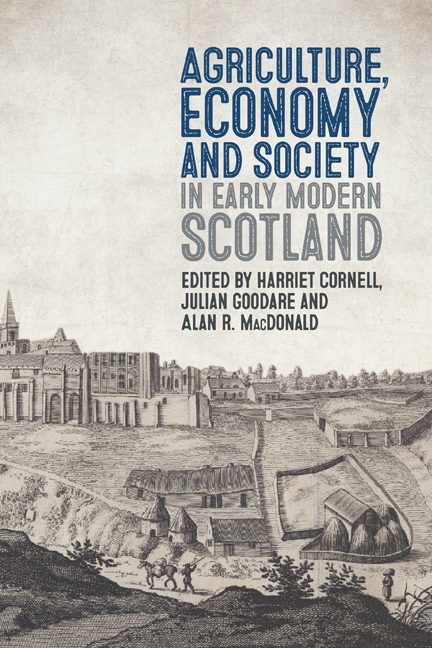Book contents
- Frontmatter
- Dedication
- Contents
- Illustrations
- Contributors
- Acknowledgements
- Note on Currency and Measures
- Abbreviations
- Map of Scotland
- Introduction: Exploring Scotland’s Agricultural History
- 1 Imagining Scottish Agriculture before the Improvers
- 2 The Use of Dykes in Scottish Farming 1500–1700
- 3 The Famine of 1622–23 in Scotland
- 4 Weather and Farming through the Eyes of a Sixteenth-Century Highland Peasant
- 5 Stock, Fermes, Mails and Duties in a Midlothian Barony 1587–89
- 6 The Roots of Improvement: Early Seventeenth-Century Agriculture on the Mains of Dundas, Linlithgowshire
- 7 ‘God Knowis my Sleipis ar Short and Unsound’: Andro Smyth’s Collection of Rent, Tax, Teind and Tolls in Shetland c.1640
- 8 Farming in the Stirling Area 1560–1750
- 9 What Were the Fiars Prices Used For?
- 10 Agriculture and Banking in Eighteenth-Century Scotland 1695–1750
- 11 Capitalism’s Cradle? Ideas, Policies and the Rise of the Scottish Economy in the Mercantilist Age 1600–1800
- Conclusion: A Historiographical and Bibliographical Overview
- Index
- Boydell Studies in Rural History
2 - The Use of Dykes in Scottish Farming 1500–1700
Published online by Cambridge University Press: 14 May 2024
- Frontmatter
- Dedication
- Contents
- Illustrations
- Contributors
- Acknowledgements
- Note on Currency and Measures
- Abbreviations
- Map of Scotland
- Introduction: Exploring Scotland’s Agricultural History
- 1 Imagining Scottish Agriculture before the Improvers
- 2 The Use of Dykes in Scottish Farming 1500–1700
- 3 The Famine of 1622–23 in Scotland
- 4 Weather and Farming through the Eyes of a Sixteenth-Century Highland Peasant
- 5 Stock, Fermes, Mails and Duties in a Midlothian Barony 1587–89
- 6 The Roots of Improvement: Early Seventeenth-Century Agriculture on the Mains of Dundas, Linlithgowshire
- 7 ‘God Knowis my Sleipis ar Short and Unsound’: Andro Smyth’s Collection of Rent, Tax, Teind and Tolls in Shetland c.1640
- 8 Farming in the Stirling Area 1560–1750
- 9 What Were the Fiars Prices Used For?
- 10 Agriculture and Banking in Eighteenth-Century Scotland 1695–1750
- 11 Capitalism’s Cradle? Ideas, Policies and the Rise of the Scottish Economy in the Mercantilist Age 1600–1800
- Conclusion: A Historiographical and Bibliographical Overview
- Index
- Boydell Studies in Rural History
Summary
Seldome lyes the divel dead by ane dycksyd.
– Scottish proverbA seventeenth-century proverb, pointing out the Devil's busy activity every day in Scotland, also reminds us that Scottish folk encountered dykes every day in the course of their busy activity in farming. Dykes were everyday aspects of the infrastructure of farming, vital but often overlooked. This chapter aims to bring these dykes to life.
* * *
The ability to separate areas of land was crucial to prevent livestock damaging crops; this role was often fulfilled by dykes within the fermtoun communities. These fermtouns were collections of families who lived close together and farmed partly together, partly as individuals. Their dykes were upright freestanding structures used to separate families’ crop areas from communal land, animals from oats, or a lord's private property from the fermtoun's domain. Other means of dividing land included ditches, and indeed during the enclosing movement both ditches and dykes were often used in combination.
Whilst the study of farming in early modern Scotland has covered a wide range of topics, little research has been done into how farming people used the dykes and what these dykes were like. Fenton and Leitch have offered a broad overview, covering mainly the period since agricultural ‘Improvement’ but with some attention to the earlier period. Dodgshon has investigated the division of land among tenants in addition to field systems and other agricultural matters, but he has not considered the variation in dykes or the people involved with the life of a dyke. Fenton's studies of Scottish farming in this period also touch on dykes; however, he does not explore this topic in depth for mainland Scotland, limiting his main investigation to Orkney and Shetland. Robertson has researched head dykes and their placement in the landscape. Shepherd has mentioned briefly that there was ‘an extensive array of pre-“Improvement” boundaries’ in north-eastern Scotland. This chapter sets out to analyse dykes both in their physical nature and in people's relationships with them.
Some of the sources are from the first half of the eighteenth century and thus from the end of early modern farming, although it must be remembered that it was only after about 1750 that agrarian change spread quickly.
- Type
- Chapter
- Information
- Publisher: Boydell & BrewerPrint publication year: 2024

